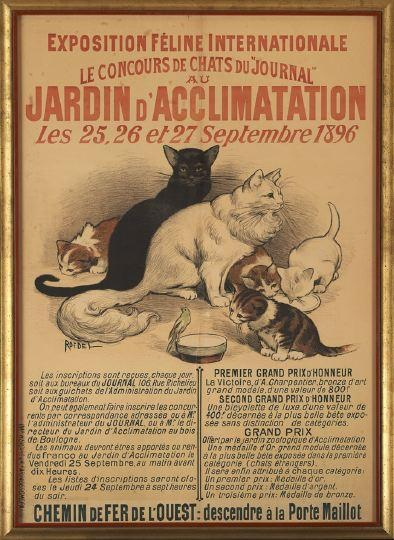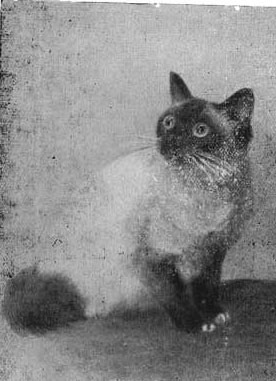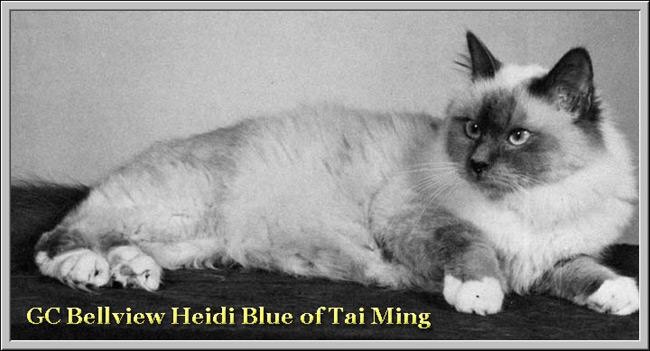
(Poupée de Madalpour - 1st Birman girl)
THE ORIGINS
(A Detective story)
By Dr. Alain Lescart PhD
The origin of the Birman is shrouded with mystery. First official recorded & documented Birmans (or Sacred Cat of Burma - Chat Sacré de Birmanie) date of 1925, in France. Birmans were only a handful and considered a luxury, therefore sold at a very high price on base of their extreme rarety (the Birman was the most expensive cat at its origin). We can however, following history, scientific data and thorough analyses of the first journal articles and chapter books published in France—accessible at the Paris National Library (Bibliothèque François Mitterand)—draw some conclusions and make connection with facts that can be verified.
The Birman appears concurrently with modern Cat Club organisations creation in France and the emergence of genealogical records. While the British (GCCF) were the first to create Cat Clubs & Shows in London—at the famous Crystal Palace (July 13, 1871), the National Cat Club of London was created in 1887, followed by the Cat Club of London in 1898. In United States, the Beresford Cat Club of Chicago and the Chicago Cat Club were created in 1899.
The French had their first Cat Shows in Paris only 25 years later (Jardin d’Acclimatation) in 1896, but these shows only stayed for a decade and disappeard at the beginning of the 1900. We need to wait 1926 to see the new modern creation of Cat Clubs in France & Belgium, and the First XXth century International Cat Show in Paris in May 14-15, 1926.

For the Birman, all begins in south of France, on the French Riviera, in Nice, around 1924-25. A Siamese breeder named Mme Leotardi, presents the number one Birman named Poupée [Doll] to the general public at the 1926 Paris Cat Show. The first actual records we have of this Birman date of 1925. That year, a veterinarian from the French Riviera who happens to also be the General Secretary of the Cat Club de France et de Belgique (Dr. Ph. Jumaud) publishes his doctoral thesis in a book called: Les Races de Chat. (1925, St Raphaël: Editions des Tablettes) [Cat Breeds]. The content of this book is also presented as a conference in 1926, at the Congress of the "Association Française pour l’Avancement des Sciences,” at Lyon (26-31 July 1926).
The short description of the Birman in this book makes its existence official and give an immediate credit to it as a breed. 1926 sees an explosion of articles on the Birman, following the First Cat show, mostly written by this same veterinarian and secretary of the Cat Club.
FIRST DESCRIPTON OF THE BIRMAN
From: “Le Chat. Races - Elevage - Maladies” by Larieux and Jumaud. 1926: Vinot Frères Editeurs. pp.40-42
(Our translation from French)
Native, like the Siamese, from Extreme-Orient, the Cats of Birma, bred in temples, are seriousy guarded and their sale is forbidden. However, a few years ago, M. VANDERBILT was able to acquire a couple from whom all the actual subjects exist.
Habits.– These cats are very sociable, intelligents, joyful, cuddling, following their masters like dogs ; there are however some exceptions and some subjects have been quite wild.
Size – These animals have a long body, the legs are thin and well proportionated. The weight at adult age varied between 3 and 4 kilogrammes.
The head is long with wide ears, up in the air, covered with hushed hair ; the forehead is domed. Males have a thick lock between the two eyes, white-cream color that give them a funny headdress like a griffon. The moustaches are thick and long. The eyes are an intense royal blue, very mobiles.
Robe.– The hair are long, like semi-angora hair and separated on the back like if they had received a comb stroke. The tail hair are very dense and make a panache.
Color.– The color is like white-cream siamese, with may be some golden tones. The mask, tail, ears and legs are all dark, the four legs are finished with a white glove stopping under the wrist.
Tail.– The tail never has nods. It is long, covered with hair making panache, up like squirrels.
Reproduction and breeding.– The breeding of these subjects has always been peculiarly difficult, and one must not expect to breed more than one subject on ten. The food that these animals like is a porridge of fish and cooked salad ; others only accept raw meat.
Point Scale.– Robe (long and hair texture) 20 ; Color and marks 20 ; head 15 ; eyes 15 ; tail 20 ; body 10. Total 100.
*****
VANDERBILT ?
The mention of M. VANDERBILT associated with the origin of the Birman [in Jumaud first edition) is not going to stay very long on the scene (not even six months). Miss Marcelle ADAM, the new prestigious president of the Cat Club has acquired a Birman from Miss Leotardi (MANOU) and is trying to get more information on the Birmanese origin of the cat. The obvious source of information has to be this Miss Leotardi, Siamese breeder. However, pretty quicky, the name of M. Vanderbilt is erased from the new descriptions and is replaced by another mysterious name: Miss Thadde Hadish with the exact same text.
The Vanderbilt are a famous rich american family (from a Dutch origin) who accumulated wealth with boat transport and railroad. The Vanderbilt name is often in the news in the 1920-30s and the cover of the September 15, 1930 TIME magazine has a picture of Harold Vanderbilt on his yacht. The best candidate would then have been Harold Stirling Vanderbilt (1884-1970) from New Port, Rhodes Island, famous yachtsman regata champion (1922-38) and executive member of the New York Central Railroad. However, Vanderbilt University records of him (Nashville, TN) indicated that he never went to Birma (Myanmar today) and eliminate him as a provider candidate for the Birman cat. It made also no sense to spent so much money, time and intrigues to acquire a rare Birman couple to get rid of them as soon as they arrive to Nice, France ! In addition, it was dangerous to mention a living person that could have corroborated or denied his implication in the acquisition.
The obvious association with the name Vanderbilt is money, in order to explain the excessive price asked for a Birman acquistion !
Note: Cornelius Vanderbilt (editor & journalist at the New York Herald never went to Birma neither).

From a very brief mention of the Birman origin (quickly collapsing), an elaborate mythic story is then developed at the next stage to provide a more solid account to support its preasssumed birman origins.
In 1926, following the Cat Show success in Paris, the French newspaper “Vie à la Campagne” (Vol. 23. No 280. October. pp. 402-403 - 3 columns )–also sponsor of the Cat Show (with the review Femina)– has a full article on the Birman [It is the first long publication we have) with the original pictures of the two first Birman exposed: POUPEE de MADALPOUR (Miss Leotardi), MANOU de MADALPOUR (Miss M. Adam). It is untitled:
"Le Chat de Birmanie, animal sacré : « Race caractérisée, qui serait à l’origine du siamois et qui se distingue nettement des races asiatiques à poil long, avec lesquelles les sujets ne sympathisent pas »
[The Cat of Burma, sacred animal ; Breed characterized, which could be at the origin of the siamese and that is clearly different from the long hair asiatic breeds, with whom it doesn’t get along.]
This interesting title already contains some elements that reflect the harsh background debate in course in France about the cat similarities with the siamese cat. The title reflects also a strong verbal counter-attack, suggesting that the Siamese comes from the Birman and not the contrary and that these two species do not get along at all. Consequently, no kittens could be produced from a possible union between the two !
How does it arrives to such an astonishing conclusion? At least, it does suggest that some breeding have been made or attempt between the two “breeds” ! It also underlines the fact that the first Birmans had many similarities with Siameses.

Poupée de Madalpour
Pictures of Siamese at this time
Three new characters are introduced to the tale: an adventurous austrian woman named Thadde Hadish erases and replaces M. Vanderbilt, and a British military "stationed in Burma” (an English colony) : Sir Russel Gordon. Later in the text, another important person will be mentioned: famous French scientist and Indochina (Cambodia-French colony) explorator: Auguste Pavie. The text also attempts to connect the Sinh Cat's legend with a rationale story.
TEXT OF THE ARTICLE:
Le chat de Birmanie est originaire de l’Extrême-Orient. Les sujets de cette race, élevés dans les temples, sont sévèrement gardés. Et leur cession en est interdite. Cependant, voici quelques années, un couple fut importé par M. VANDERBILT Mme Thadde Hadish (couple qui a donné souche à la famille de « Madalpour ») ; ce couple fut vraisemblablement dérobé par un serviteur du temple ébloui par des promesses et qui aura pris la fuite, pour éviter le châtiment, car, pour qui connaît le fanatisme des Hindous, jamais personne ne croira que des prêtres aient vendu, même à un prix fabuleux, un couple de leurs animaux sacrés. Le major Sir Russel Gordon, faisant partie des troupes britanniques chargées de protéger les kittahs, eut, en 1898, l’occasion d’observer ces animaux sacrés. Il en dressa un standard qui corrobore celui établi en 1925 dans notre thèse de doctorat.
TRANSLATION
The Birman cat originated from Extreme-Orient. The subjects of this breed, bred in temples, are severely guarded. Their sale is forbidden. However, few years ago, a couple was imported by Miss Thadde Hadish (couple that gave stub to the “Madalpour” family) ; this couple was in all likelihood stolen by a temple servant dazzled by promises and who would have escaped, to avoid punishment, because, for who knows the Hindus' fanatism, nobody would ever believe that priests would have sell, even at a fabulous price, a couple of their sacred animals. Major Sir Russel Gordon, being part of British troops in care of the Kittahs protection, had, in 1898, the privilege to observe these sacred animals. He made a standard that corroborated the one established in 1925, in our doctorate thesis.
Several notorious Birman breeders in the 1920-30 (Mr. Marcel Reney-1st president of the Swiss Cat Club & Marcel Baudoin) tried to contact this exotic Miss Thadde Hadish without any success. She was fantasmatic and unattainable ! Her name was as mysterious as her location. Hadish is a Persan name meaning “Heaven”. It is also the name given to Mohamet’s Traditions. The first name Thadde, is Hebraic (Thaddeus) and mainly masculine (one of the 12 apostles). One more time, it doesn’t make any sense that this Persan “Lady Heaven” would have gone through so much trouble to get rid of the cats in Nice! Or may be, she was just used to justify the arrival/sale of one female: Poupée de Madalpour! She serves the tale for the Burma provenance of the cat and then disappeared after use, like the first Mme Eloise Bovary in Flaubert famous novel !
As unattainable was this Sir Russel Gordon ! There are no records of him anywhere in English Burma-war archives in 1898. Therefore, it is, very conveniently, impossible to confirm or deny anything. It was however necessary to provide an English connection because the French and the British were in huge tension in this part of the world divided between British colonies (Burma) and French Indochina colonies (Cambodia). No one was able to enter Burma without British supervision ! In addition to this, some geographic elements were provided. Strangely enough the cities mentionned correspond exactly to Burma French maps of this time in the northern part of the country. What should we say about the Kittah priest (Kittah-Kitten)? Unknown. About the goddess Tsun-Kian Ksé? Unknown ! … About hinduist temples in one of the most important bouddhist country … ?
Mr Marcel Baudoin, probably one of the most important pre-war Birman breeder, wrote a long artice on the Birman in the Revue Feline Belge of December 1929, following an investigation conducted by himself (trying to find and contact the parties mentionned) with he following conclusion: “Evidemment nous sommes dans le domaine de la fantaisie. La réalité est moins belle.” [Obviously, we are in the domain of Fantasy. The reality is less pretty.]
...
Bilbiography at the end of this page.
*****
FIRST BIRMANS IN THE UNITED STATES
(From the CFA website)
The first Birmans of record arrived in the U.S. in 1959, imported by Dr. and Mrs. John Seipel. In 1961 two seal point cats were sent to Mrs. Gertrude Griswold of Tacoma, Washington, as a gift from Cambodia. It was later discovered that these cats were in fact Sacred Cats of Burma (not originated from the area). Correspondence with breeders in France resulted in the exchange of kittens and Mrs. Griswold's cattery, originally called Clover Creek, but later changed to Griswold, was established. One of her cats, Korrigan of Clover Creek, sired CFA's first Birman grand champion. Another early breeder was Mrs. Verner Clum, Gaylands Cattery. Both Mrs. Griswold and Mrs. Clum have since passed away.

Frances Price, Tai Ming Cattery, had the good fortune to receive cats from Mrs. Griswold and Mrs. Clum, as well as from Mrs. Fisher's Praha Cattery to form the foundation of her cattery. Her breeding program has been very successful over the course of the past 30 years, and she is a faithful follower of Birmans at the breed shows as well as in her region. Following in her pioneering ways, in 1995 she added two seal lynx point females to her cattery.

Ed and the late Harriet Rindfleisch, Rindy's Haven Cattery, imported their first Birman from England in 1970. Harriet left as a part of her legacy a number of letters and articles regarding Birmans that may be found on the Sacred Cat of Burma Fanciers website (http://www.scbf.com). Melanie Kreidl (Tarazed Cattery), who passed away within the past year, made a major contribution to our breed, especially in the propagation and improvement of chocolates and lilacs. Maureen Escalette and her late husband Joseph (Celtic Cattery) as well as Walter and Betty Cowles (Oxdowne Cattery) were also early Birman breeders who have had an indelible impact on our breed. funny